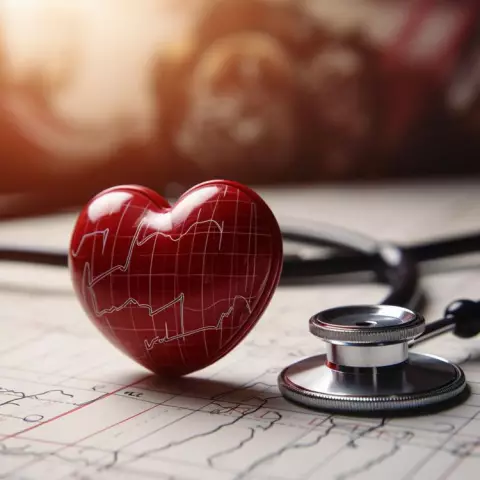- Author Curtis Blomfield [email protected].
- Public 2023-12-16 20:44.
- Last modified 2025-01-23 17:01.
Today, there is a huge number of heart diseases. The most common among them is considered to be ventricular arrhythmia, which occurs as a result of premature excitation of impulses that come from the ventricular system. In this case, the rhythm of the heart is disturbed, extraordinary contractions of its lower sections appear. Ventricular arrhythmia today is observed in 60% of people, most often in old age. Sometimes a heart rhythm disorder can be found in young he althy people. What causes the occurrence of this pathology, what symptoms it has and how to treat it - we'll talk about this.

Description of the disease
The disease is a disorder of the heart's rhythm, when conductive impulses are formed in the heart ventricles, below the place where the bundle of His forks. Ventricular arrhythmia, treatment and symptoms, we will consider below, there are different types. They act as conditions that threaten the appearance of severe disorders in the work of the heart, as well as a sudden cessation of the activity of this organ. Also canasymptomatic, mild forms of arrhythmias appear.
Forms of ventricular arrhythmias
In medicine, it is customary to distinguish three groups of this kind of disease: extrasystole, tachycardia and fibrillation (flicker). Depending on the form of manifestation of the disease, appropriate treatment is prescribed. In addition, the symptoms of the manifestation of arrhythmias can also vary. Let's take a closer look at this issue.

Extrasystole
This form of the disease is one of the most frequently reported, it is caused by premature contraction of the heart. Ventricular arrhythmia (extrasystole) is found in 70% of people of different ages, its appearance is often caused by stress, alcohol and nicotine, coffee. Also, arrhythmia of this form can occur when the myocardium is damaged due to the development of various diseases.
There are five classes of extrasystole, you can detect the presence of one of them using an ECG for twenty-four hours:
- zero class implies the absence of extrasystoles;
- the first class is characterized by the appearance of no more than thirty single contractions for one hour;
- the second class is characterized by the appearance of more than thirty single contractions for one hour;
- the third class suggests the presence of polymorphic extrasystoles;
- the fourth class implies the presence of paired polymorphic or monomorphic abbreviations;
- the fifth grade is characterized by group contractions, sometimes tachycardia attacks are possible.

Tachycardia
Ventricular arrhythmia of this form is manifested by an increase in the heart rate (more than 90 beats per minute). Tachycardia can manifest itself both as a pathology and as a physiological phenomenon during attacks of fear, physical exertion, and so on. Most often, it is a symptom of the development of various disorders of the endocrine, autonomic nervous systems. Tachycardia as a pathology can lead to bad consequences. So, blood pressure drops, blood flow to organs slows down, blood supply to the body and the heart, including, worsens, which leads to the risk of coronary disease or heart attack. There are several classes of tachycardia:
1. Sinus - there is a violation of the transmission of impulses to the ventricles from the sinus node. This can be either the result of a malfunction of the node itself, or stress, fear, and so on.
2. Paroxysmal - there is an attack of heartbeat up to 300 beats per minute, which occurs and disappears suddenly. This may be due to an increase in the activity of the sympathetic nervous system, as well as changes in the myocardium. Most often it occurs in the second case and is observed in most cases in men. Such tachycardia can develop into ischemia, hypotension, and also into ventricular fibrillation. Continuous attacks of tachycardia have a detrimental effect on the body's blood circulation, increasing the risk of death.

Fibrillation
ventricular fibrillation, orfibrillation, characterized by a heartbeat of up to 480 beats per minute, while the ventricles contract uncoordinated, the heart eventually stops, the person dies. Fibrillation is often the result of a heart attack. In medicine, it is customary to distinguish between several classes of atrial fibrillation:
- Primary - appears in the first two days after the onset of a heart attack and is a common cause of sudden death in people.
- Secondary ventricular fibrillation develops due to cardiogenic shock in those suffering from a heart attack.
- Late fibrillation appears in the fourth week of the disease.
Fibrillation in all cases begins suddenly. Three hours after its appearance, the head begins to spin, weakness appears. After twenty hours, a person loses consciousness, after forty hours convulsions begin, the pupils dilate, breathing gradually becomes less frequent, and then stops altogether, clinical death occurs.

Classification
Depending on what consequences can be developed after ventricular arrhythmia of the heart has appeared (symptoms will be discussed in this article), it is customary to single out:
1. Functional arrhythmias are characterized by the absence of heart lesions, which are serious. There are practically no complications after.
2. Arrhythmias that are dangerous to humans and develop against the background of heart disease, mortality in this case increases.
3. Malignant developmentheart rhythm disturbances, appears with serious heart disease and often leads to death.
Reasons for appearance
The development of arrhythmias can occur for various reasons, sometimes they are unknown. In the latter case, it is customary to talk about the disease, which is idiopathic in nature. Most often, ventricular arrhythmia (symptoms, treatment and prognosis will be discussed below) occurs as a result of the development of a heart disease: ischemia, heart attack, cardiosclerosis, mitral valve damage, as well as myocardial inflammation, hypertension, which is malignant, pulmonary pathology. In some cases, VVD, hernia and osteochondrosis can also cause arrhythmias. Idiopathic arrhythmia is provoked by external factors: smoking, drinking alcohol and coffee, frequent use of heart medications.

Symptoms and signs
Ventricular arrhythmia has no clear symptoms. Different people may have different sensations, which do not depend on the cause of the disease. Most often, patients experience weakness, shortness of breath, dizziness. The manifestation of symptoms on the ECG is clearly visible. First of all, there is an increase in size and deformation of the tooth, which is part of the ventricular complex. More than three contractions of the heart in a row also indicate the presence of arrhythmia. Paleness, anxiety, increased sweating, a feeling of shortness of breath, interruptions in the work of the heart are inherent in extrasystoles. With tachycardia, dizziness is observed (up to loss of consciousness), pain in the heart, severepalpitations, shortness of breath, hypotension, convulsions. Fibrillation often manifests itself in the form of fainting, chest pain, pulmonary edema, pulse deficit. Her symptoms are due to the fact that the ventricles contract quickly and irregularly.
Diagnosis of disease
Ventricular arrhythmia can be confirmed by ECG monitoring, exercise ECG, VEM or treadmill test. The study involves recording heart impulses using electrodes that are placed on the skin of a person's chest, as well as on his arms and legs. The readings are recorded on the monitor, after which they are transferred to a printing device and printed on paper. With VEM, indicators are taken during exercise, for this an exercise bike is used. The treadmill test uses a treadmill. In the case of diagnostics, it is necessary to take into account those factors that influence the onset and cessation of seizures. This includes the emotional and mental state of the patient, physical activity, medication, and so on. Additional research methods for the presence of arrhythmias are: radiography, tomography, ultrasound of the heart. Further treatment of the disease will depend on the results of these tests.
Ventricular arrhythmia: treatment
When a disease is detected, not all cases require special treatment. With drug treatment, it is recommended to pay attention to the side effects of drugs, as well as the duration of their intake, since it is possible to unreasonably harm he alth. In some pathologies of the heart, the use of drugs fromarrhythmias, as this can lead to cardiac arrest. Consider the methods and ways of treating arrhythmias in its various forms.
Treatment of extrasystoles
In frequent cases, this disease is associated with a lack of electrolytes in the human body, which is detected by a blood test. Therefore, a magnesium-potassium diet is often recommended for extrasystoles. You should also pay attention to sleep and rest, diet, bad habits, frequent coffee consumption, stress, and so on. Sedatives may be prescribed. If ventricular arrhythmia is severe, then medication is prescribed, and in some cases surgery is required. The patient is prescribed electrolytes, ACE inhibitors, nitrates, and so on. Anti-arrhythmia drugs are of great importance here.

Treatment of tachycardia
There are two groups of medicines, the action of which is aimed at the treatment of tachycardia: sedatives and antiarrhythmic drugs. Sedatives are attributed in the event that there is a GVA. It can be "Diazepam", "Persen", "Glycine" and others. Antiarrhythmic drugs for ventricular arrhythmia are prescribed after the cause of the pathology is established. It can be "Verapamin", "Anaprilin", "Adenosine" and so on. In any case, a specialist should deal with the treatment.
Fibrillation treatment
If an attack of fibrillation appeared for the first time or is intermittent, it is necessarystop with the help of "Quinidine", "Cordorone" or "Novocainamide". If fibrillation is permanent, you should always take drugs to prevent stroke. In this case, anticoagulant therapy is appropriate, you need to take acetylsalicylic acid, Warfarin, heparins.
Prognosis for arrhythmias
The prognosis for such an ailment will depend on its form, the presence of heart pathology, and circulatory disorders in humans. Ventricular and supraventricular arrhythmias, which are not associated with heart disease, do not threaten human life and he alth. If the disease develops against the background of heart disease, the prognosis will be unfavorable. Life expectancy here will depend on timely treatment. Therefore, it is recommended to monitor the performance of the heart and follow all medical recommendations, then the disease can be stopped. At the same time, one should not forget about preventive measures, since taking care of one's he alth can play a big role, and in some cases, save a person's life.
Prevention
First of all, the prevention of arrhythmias is aimed at treating heart pathology, which contributes to rhythm and conduction disturbances. It is also necessary to exclude the causes of the onset of the disease, these can be intoxication, VDS, stress, electrolyte imbalance, etc. It is necessary to limit the intake of alcohol, nicotine and caffeine, as well as the independent use of drugs against arrhythmia. Treatment should be carried out strictly by a doctor. Thus, disease prevention is as follows:
- treatment of major heart ailments;
- diet;
- exclusion of bad habits;
- control of physical activity, weight, pressure;
- prevention with medicines.
It is recommended to take Panangin (potassium and magnesium), vitamin B6, Ritmonorm, Allapinin and others as drugs.
With arrhythmia, you can play sports, but physical activity should be small. Do not overload the body. By following all the recommendations and taking care of your he alth, you can save not only your he alth, but also your life, and the doctor, in turn, will help you decide on the choice of drugs.






